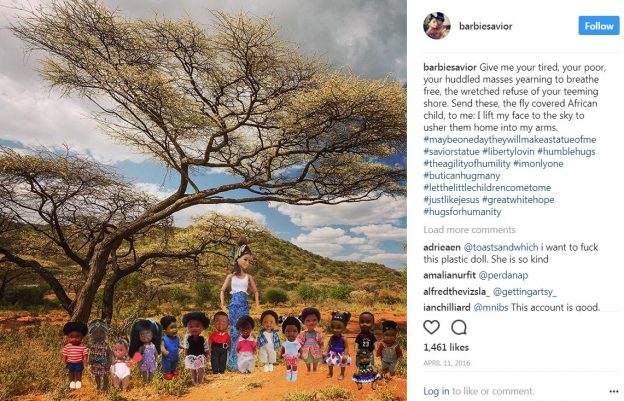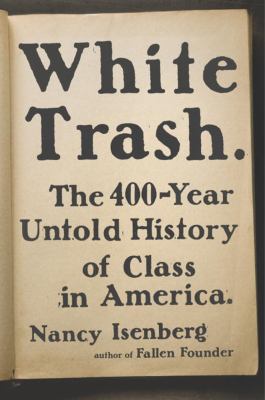20+ Relevant Terms for Discussing Whiteness
As a supplementary addendum to the “what is whiteness?” blog post, display and StoryCorps interview, some Middlebury staff and faculty have put together an informal glossary of terms that helps the community to discuss whiteness. For more on these terms, use reference materials and other published works found on this crowd-sourced list and beyond.
Contributors’ Names; Hometowns; Roles on Campus; Times At Midd:
- Katrina Spencer; Los Angeles, California; Literatures and Cultures Librarian; 10 months.
- Daniel Silva; Newark, New Jersey; Professor of Portuguese; 4 years
- Laurie Essig; from a lot of places, mostly NYC; Professor of Gender, Sexuality & Feminist Studies; 11 years
- Amy Frazier; Memphis, Tennessee; Film & Media Librarian; 2 years.
- Tara Affolter; Peoria, Illinois; Professor of Education Studies; 9 years
Terms:
bleaching/whitening; columbising; colorism; cultural (mis)appropriation; dominant culture/hegemony; double consciousness; Eugenics; invisibility/hypervisibility; miscegenation; passing; WASP; white anxiety; white fragility; white gaze; white guilt; white privilege; white savior complex; white supremacy; white tears; white trash; wypipo
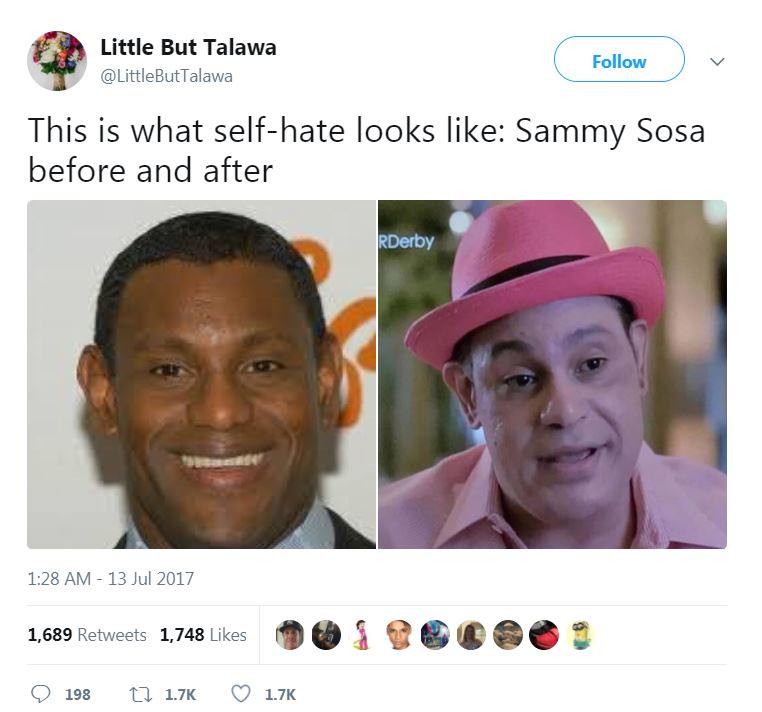
A screenshot from Twitter user @LittleButTalawa‘s feed depicting before and after pictures of former baseball star Sammy Sosa, an athlete from the Dominican Republic. He has deep brown skin on the left and considerably paler skin on the right.
bleaching/whitening: Both of these terms describe processes in which people attempt to alter/reduce the pigmentation in their skin, typically to increase their social capital or perceived social capital. An additional element of this practice can include people avoiding exposure to the sun for fear of its potential skin darkening effect. In many cultures, bleaching and whitening reflect a prioritization and preference for a beauty paradigm that values pale/light skin. To see more on this industry and samples of products used for this practice, visit Dencia’s Whitenicious page. (Katrina)
columbising (see definition 6.): a facetious term that alludes to Christopher Columbus and is meant to reference the ways in which white people can at times falsely/errantly “discover” cultural products, practices and/or traditions that are foreign and novel for them yet have years, decades and/or centuries of history within other cultural groups, for example, foods (e.g. phở) or hairstyles (e.g. cornrows). The “columbuser” will then announce the cultural products, practices or traditions to mainstream consumers and attempt to popularize and/or profit from them either through monetary benefit or increased social capital via consumption/practice (Katrina).
colorism: a sociocultural phenomenon in many parts of the world including the United States, Brazil, parts of Subsaharan Africa, India and parts of East Asia in which people frequently of a lighter skin tone are seen as more beautiful than people of darker shades. In these social milieus, people whose skin more closely matches that of typical Western Europeans’ are granted greater social capital and status and afforded more desirable opportunities, for example, choice of mating partners, representations in media, job opportunities, etc. (Katrina).
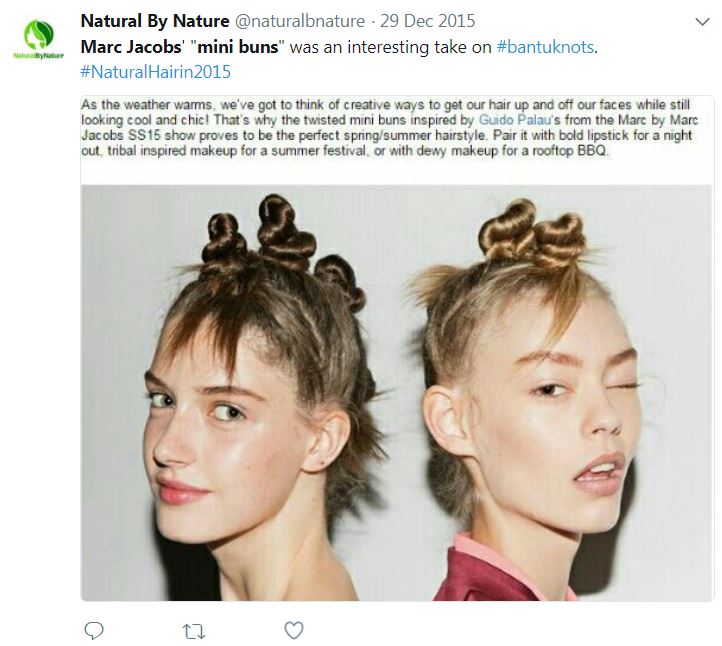
A 29 December 2015 screenshot from Twitter user @naturalbnatures’ feed of two white models wearing a hairstyle known within black communities as “Bantu knots.” The hairstyle was dubbed “messy knots” or “mini buns,” something perhaps novel for whites.
cultural (mis)appropriation: a sociocultural phenomenon in which a member of one cultural group usurps a cultural practice from another group. For example, white women might try to style their hair in afros. White people may try to use the “n-word” as a term to express intimacy with peers. White people may try to imitate a cultural dance from a black group. Or, a popular clothing maker may take textile designs from a cultural group and use them in/on their products without the intention of the cultural group benefiting from the purchase and frequently without the intention of understanding the cultures that produced the design. For example, in the 1990s, Gwen Stefani wore a bindi at the center of her forehead. The decoration became a sort of trademark but was almost completely if not entirely divorced from the cultural practice and practicants that developed this tradition (Katrina).
dominant culture/hegemony: Italian Marxist thinker Antonio Gramsci developed the term “hegemony” in relation to industrial capitalism in the early twentieth century. Since then, the term has come to refer to the race-based power relations and western societal hierarchies inaugurated by European expansion and reproduced through interrelated modes of oppression and exploitation such as slavery, global capitalism, and apartheid. More than power relations, the term articulates the existence of a dominant culture that has legitimized and normalized such relations and hierarchies. The hegemony of whiteness can thus be found in its construction as superior and normative in terms of intelligence, creativity, beauty, health, and sexuality; all of these being tools of oppression (Daniel).
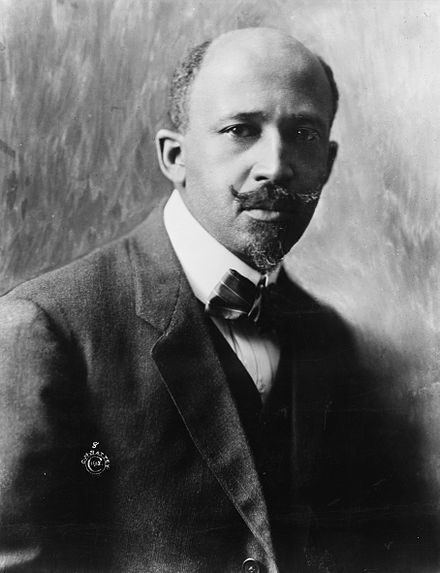
An image of social thinker W.E.B. DuBois, one of the African American pioneers who gave voice to race relations from a black perspective.
double consciousness: Originally coined by African-American sociologist, historian, and intellectual W.E.B. Du Bois. The term refers to the seemingly multiple ways in which an individual relates to history and society according to different categories of identity such as race, ethnicity, gender, class, and sexuality. These are not neatly separable but rather mutually impact one another. Using himself as an example, Du Bois argued that he saw the world as both a citizen of the United States and as someone of African descent, but equally important, how being of African descent impacted how he thought of his Americanness and vice versa. Du Bois also refers to double-consciousness as seeing oneself through both their own eyes and through the eyes of a society structured by white hegemony (Daniel).
Eugenics: Eugenics was (and is) a highly popular and widespread set of beliefs about producing “better” humans through science. Eugenics departments were present at most major universities and colleges, including Middlebury. It was also supported by the Carnegie and Rockefeller foundations. Major intellectuals of the early 20th century, including African-American scholar and civil rights activist W.E.B. Dubois and birth control pioneer Margaret Stanger, identified with eugenics. Eugenics were marshalled as an argument for distributing information about birth control since allowing women access over when and if they reproduced was an extremely important step for creating the conditions for more gender equality and as a way to mitigating the effects of high birth rates on poverty. Eugenics was also the reason that tens of thousands of women, all poor, many of color, were forcefully sterilized after the 1927 Buck v. Bell Supreme Court decision that made it legal for states to prevent persons of low IQ from giving birth. Because American eugenics were often used within Nazi ideological justification for genocide, eugenics became less popular after World War II, although eugenicist thinking still thrives in the US and elsewhere, whether through the creation of “designer babies” or the abortion of “imperfect” fetuses (Laurie).
invisibility/hypervisibility: The seemingly contradictory existence of whiteness widely disseminated as the dominant standard and simultaneously as unmarked in relation to the forms of otherness it has historically constructed. Within the alignment of whiteness as dominant culture/hegemony (see above), the construction of whiteness as normative makes it the subject of knowledge and non-whiteness as its object of study, onto which various forms of social and biological illness and deviance are placed. As a result, whiteness is far less susceptible to the hyper-vigilance that accompanies othering and exploitation. Meanwhile, in establishing itself as the racial embodiment of legitimate personhood, whiteness is also widely disseminated in cultural production as the “standard” – be it of beauty, gender identity, intelligence, or sexuality (Daniel).
miscegenation: This term refers to the mixed, sexual mating of people deemed to be of distinct racial origin/groups. In my estimation, it seems not to highlight the sexual act itself, per se, but rather the offspring produced from the sexual act. Sexual contact, i.e. legalized rape, for example, between white men and black women during times of slavery seems to have been an entrenched part of the socioeconomic institution; the children produced from this contact, however, were the social taboo and “open secret” (Katrina).
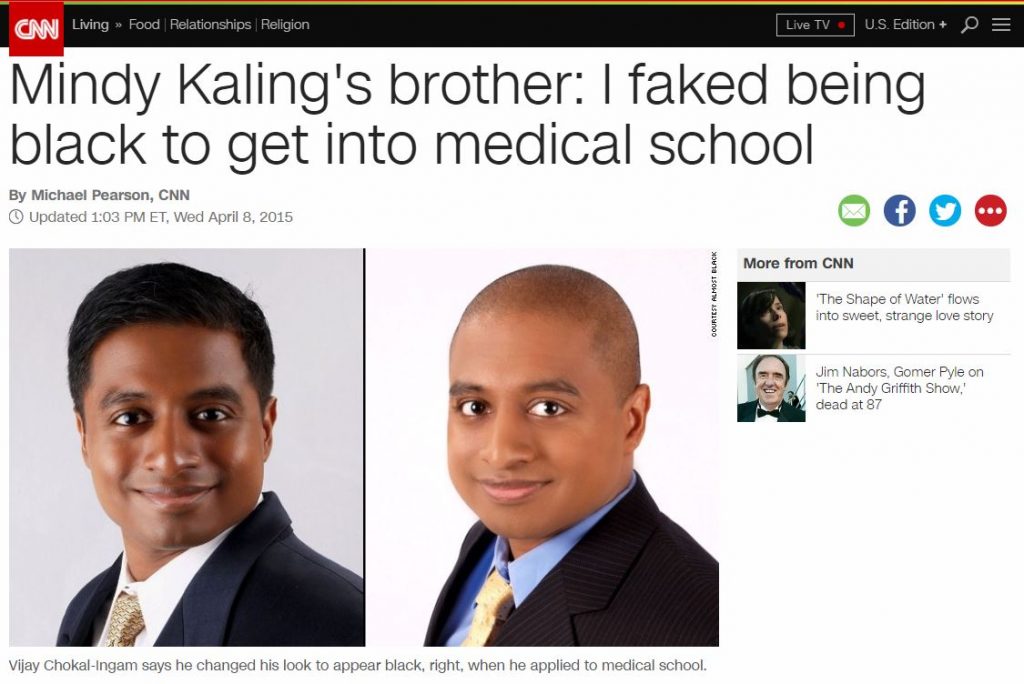
An 8 April 2015 screenshot from CNN featuring before and after photos of Vijay Chokal-Ingam, a man who attempted to pass as black in order to gain a competitive edge for medical school admissions.
passing: This term describes a cultural phenomenon in which a member of a particular racial/ethnic group has enough physical characteristics that he/she/they can convincingly be believed to belong to another racial/ethnic group. Frequently the “passer” has a social motivation to want to fit in with another group because some benefit is associated with another group. For example, light-skinned African Americans with a fine texture of hair might accept being identified as white because it has allowed them to live in certain neighborhoods, receive loans/credit for establishing assets or prevented them from experiencing discrimination, persecution or violence. Passing, again, implies that there is an incentive to be dishonest or only partially forthcoming about one’s background. Vijay Chokal-Ingam, for example, a man of South Asian descent, passed as an African American in an attempt to increase the chances of his acceptance into medical school (Katrina).
WASP: White, Anglo-Saxon Protestant, usually implying upper-middle or upper-class white people who tend to occupy positions of relative wealth and power in American society. The term specifically excludes people of Eastern or Southern European descent and Catholics — e.g., Irish, Italians, Jews, and other groups of people who have not always been considered really “white” (Amy).
white anxiety: This stems from white fragility (see below) and usually comes in the form of a white person being concerned about appearing to be racist when engaged in conversations about race (Tara).
-I would add that white anxiety also reflects a fear that the status, social positions of power and security held by many whites for decades, if not centuries, is being destabilized and approaching some sort of end. This insecurity can manifest itself in voting patterns, outbreaks of violence, targeting of minorities and anyone deemed “other” or “un-American.” It is a fear of disrupting the status quo (Katrina).
white fragility: The most clear definition and explanation of this term comes from Robin Di’Angelo’s widely circulated piece “White Fragility” (International Journal of Critical Pedagogy, 2011). She writes, “white fragility is a state in which even a minimum amount of stress becomes intolerable, triggering a range of defensive moves,” (p. 57). The triggers to white fragility are quite varied and can range from someone suggesting that a white person’s point of view is racialized (not objective); to being challenged on racism by other whites; to people of color openly discussing their experiences with race and racism and so on. When white fragility is triggered, whites often look to find a white racial equilibrium in which their own world view is seen as neutral and normal and not impacted by race, racial identity or racism (Tara).
white gaze: Toni Morrison does brilliant work around rejecting the white gaze and refusing to allow white sensibilities, pressures, and judgment to shape what her art and life can or should be. The white gaze is rooted in notions of white as the ultimate arbiter of taste, audience, and consumption. The white gaze influences how stories are told, who tells them, and who decides their importance. For example, there were two post-Hurricane Katrina photos of men, one white, one black, wading through waters with supplies they salvaged from stores. The white man’s caption reads something like: “man, finds emergency supplies for his family.” The black man’s caption reads, “man loots store in aftermath of Katrina.” The dominant white gaze defines one as heroic and the other as sinister (Tara).
white guilt: When whites are faced with the history of whiteness, the contemporary manifestations of this white guilt can result. This guilt is often part of a white person confronting the paradox of trying to be a “good person” while living within and seemingly benefiting from a racist system. The phrase “white guilt” is usually used as a critique of those that note the horrors of white supremacy but do not confront it or take action beyond “feeling bad” (Tara).
-Yes, I would add that “white guilt” is an unpleasant sentiment of shame and perceived powerlessness that many contemporary white people feel when considering the impact and legacies of slavery, colonialism, the massacres of indigenous peoples, the usurping of land, inner city violence within ghettoes, etc. that have been shaped by their ancestors and the policies they developed that have led to these conditions and inequities (Katrina).
white privilege: Largely a system of rewards rooted in whiteness that benefit those who have been deemed white. This term has been used and misused over the years. One of the more popular definitions comes from Peggy McIntosh’s now standard piece, “Unpacking the Invisible Knapsack.” In this piece, McIntosh offers a list of unearned privileges bestowed on whites by virtue of their skin color: from bank loans to representations of whites in curricula to claims of individuality (Tara).
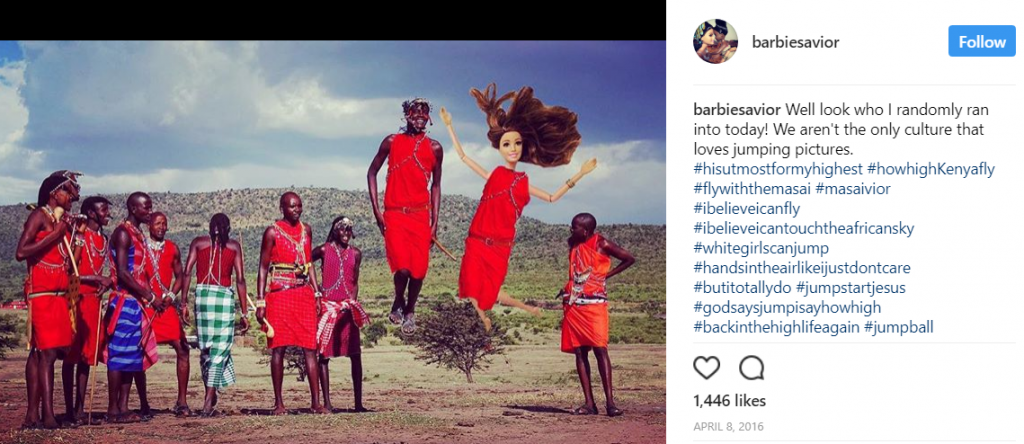
A screen capture from a satirical Instagram page featuring a fictional character called “Barbie Savior.” It is meant to derisively depict a certain type of humanitarian who attempts to serve people and causes in developing nations yet does so in an overconfident manner that can be harmful, does so while attempting to document and publicize his or her altruistic efforts as widely as possible and does so often in a self-congratulatory way that exploits and/or misrepresents communities outside of the United States.
white savior complex: This term describes the rather entrenched motif promulgated in, through and by Western cultures that depicts white people as the ultimate and heroic problem solvers within the societies they inhabit and, importantly, the ones they do not. This ideology is heavily represented in film– see Superman, any James Bond film, the Bourne series, Avatar, etc.– and has motivated religious missionary movements, numerous instances of colonialism and much of the voluntourism we see today. This complex suggests that whites, particularly men, are capable of dominating any terrain and should. Moreover, it suggests that whites’ interventions in conflict and suffering is needed/desired/unquestionably beneficial wherever and whenever they choose to engage their attention and resources. This term is closely related to themes treated in Rudyard Kipling’s “The White Man’s Burden” (Katrina).
white supremacy: Intimately tied to and residing at the core of the hegemony of whiteness, the term refers to the belief that whiteness is superior to other racial and ethnic identities. More than a belief, white supremacy has also been a “scientific” argument utilized by whites in power (and not only) in order to legitimize their political, military, and economic domination over lands and bodies defined as non-white. In this sense, white supremacy is an ideology (a way of viewing and understanding the world) that is held not only by right-wing extremists and many conservatives. It is also one that often structures societies and their institutions and cultures, especially in locations that have been impacted by colonialism and slavery (Daniel).
white tears: A defense mechanism often deployed to prevent or end the expression of a person of color’s perspective or anger. Closely related to “white fragility,” white tears offer a way to shut down or derail a conversation and redirect attention to the hurt feelings or discomfort of the white person (Amy).
white trash: “White trash” is a term that dates back three hundred years to describe white Americans who were so poor that even African-American slaves, who had almost no political rights, protections or opportunities for socioeconomic advancement, referred to them as “trash.” In fact, the idea of hating poor white people goes back even further to England in the 1600s. There poor whites, or,“human offal” (meat scrap that has no use), were considered both responsible for their own poverty and disposable. This “human offal” was swept up from poorhouses and off the streets of London and sent to the New World to act as “fertilizer” and allow those considered fully human (the settlers) to flourish. The hatred of poor people and the blaming of them for their own poverty runs deep in the US. In the 1990s, “white trash” was reclaimed by some poor whites and working class whites as a badge of honor, as in “white trash cooking.” In some ways, the term can function similarly to “redneck” as a sign of class solidarity, but “white trash” is also always a more debased position than “redneck” (Laurie).
wypipo: a facetious term used on the Internet that is phonetically approximate to “white people” when pronounced aloud. It is intended to mock and deride and is used when the actions, practices, thoughts and/or beliefs of white people, collectively, are false, heinous, objectionable, problematic and/or simply deemed worthy of derision (Katrina).
